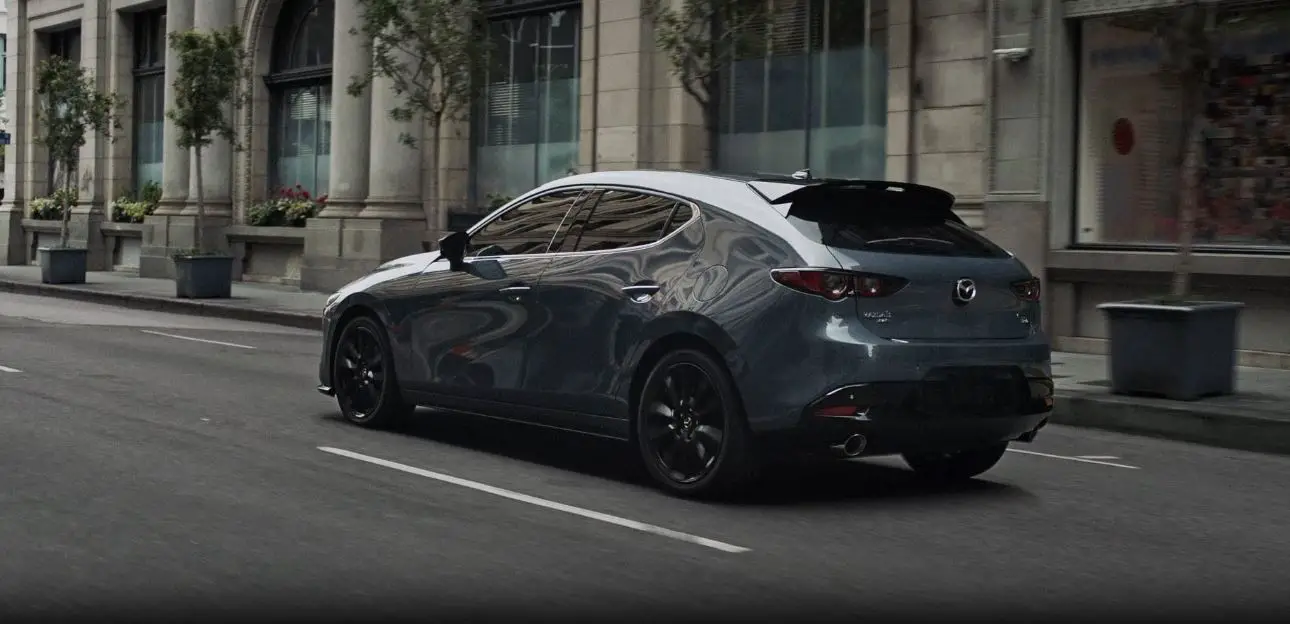Mazda 3 Hatchback 2023 SRS Air Bags User Manual
Introduction
The Mazda 3 Hatchback has long been a popular choice among drivers who appreciate style, versatility, and thrilling performance. Mazda has taken safety to new heights in the latest 2023 model by equipping the vehicle with an advanced SRS (Supplemental Restraint System) airbag system. Mazda prioritizes safety, and the SRS airbags in the Mazda 3 Hatchback 2023 demonstrate their unwavering commitment. These cutting-edge airbags are designed to provide optimal protection in the event of a collision, and they work in tandem with other safety features to form a comprehensive safety system.
Mazda’s dedication to safety is further demonstrated by the inclusion of curtain airbags in the Mazda 3 Hatchback 2023. These airbags deploy from the roofline, protecting all occupants’ heads in both the front and rear seats. This comprehensive airbag system keeps everyone inside the Mazda 3 Hatch safe.
Supplemental Restraint System (SRS) Precautions
Supplemental Restraint System (SRS) Precautions The front and side supplemental restraint systems (SRS) include different types of air bags. Please verify the different types of air bags which are equipped on your vehicle by locating the “SRS AIRBAG” location indicators. These indicators are visible in the area where the airbags are installed. The air bags are installed in the following locations:
- The steering wheel hub (driver air bag) The front passenger dashboard (front passenger air bag) Under the instrument panel (driver and front passenger* knee air bags)
- The outboard sides of the front seatbacks (side airbags)
- The front and rear window pillars, and the roof edge along both sides (curtain airbags)
Vehicles with the Front Passenger Occupant Classification System have a sensor which detects an impending roll-over accident. The air bag supplemental restraint systems are designed to provide supplemental protection in certain situations so seat belts are always important in the following ways: Without seat belt usage, the air bags cannot provide adequate protection during an accident. Seat belt usage is necessary to:
- Keep the occupant from being thrown into an inflating air bag. Reduce the possibility of injuries during an accident that is not designed for air bag inflation, such as rear impact. Reduce the possibility of injuries in frontal, near frontal or side collisions or roll-over accidents that are not severe enough to activate the airbags.
- Reduce the possibility of being thrown from your vehicle. Reduce the possibility of injuries to the lower body and legs during an accident because the air bags provide no protection to these parts of the body. Hold the driver in a position which allows better control of the vehicle.
If your vehicle is also equipped with a front passenger occupant classification system, refer to the Front Passenger Occupant Classification System for details. If your vehicle is equipped with a front passenger occupant classification system, the front passenger airbag deactivation indicator light illuminates for a specified time after the ignition is switched ON. 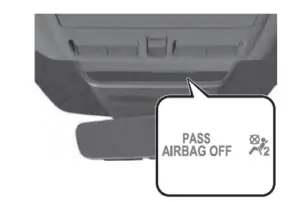 Small children must be protected by a child-restraint system as stipulated by law in every state and province. In certain states and provinces, larger children must use a child-restraint system Carefully consider which child-restraint system is necessary for your child and follow the installation directions in this Owner’s Manual as well as the child-restraint system manufacturer’s instructions.
Small children must be protected by a child-restraint system as stipulated by law in every state and province. In certain states and provinces, larger children must use a child-restraint system Carefully consider which child-restraint system is necessary for your child and follow the installation directions in this Owner’s Manual as well as the child-restraint system manufacturer’s instructions.
WARNING Seat belts must be worn in air bag equipped vehicles: Depending only on the air bags for protection during an accident is dangerous. Alone, air bags may not prevent serious injuries. The appropriate air bags can be expected to inflate only in the first accident, such as frontal, near frontal or side collisions or roll-over accidents that are at least moderate. Vehicle occupants should always wear seat belts.
Children should not ride in the front passenger seat: Placing a child, 12 years or under, in the front seat is dangerous. The child could be hit by a deploying air bag and be seriously injured or even killed. A sleeping child is more likely to lean against the door and be hit by the side air bag in moderate collision to the front-passenger side of the vehicle. Whenever possible, always secure a child 12 years and under on the rear seats with an appropriate child-restraint system for the child’s age and size.
Never use a rear-facing child-restraint system in the front seat with an airbag that could deploy: Rear-facing child-restraint systems on the front seat are particularly dangerous even though you may feel assured that a front passenger air bag will not deploy based on the fact that the front passenger air bag deactivation indicator light illuminates. The child-restraint system can be hit by a deploying air bag and moved violently backward resulting in serious injury or death to the child.
Do not sit too close to the driver and front passenger air bags: Sitting too close to the driver and front passenger air bag modules or placing hands or feet on them is extremely dangerous. The driver and front passenger air bags inflate with great force and speed. Serious injuries could occur if someone is too close. The driver should always hold onto only the rim of the steering wheel. The front seat passenger should keep both feet on the floor. Front seat occupants should adjust their seats as far back as possible and always sit upright against the seatbacks with seat belts worn properly.
Sit in the center of the seat and wear seat belts properly: Sitting too close to the side air bag modules or placing hands on them, or sleeping up against the door or hanging out the windows is extremely dangerous. The side and curtain air bags inflate with great force and speed directly expanding along the door on the side the car is hit. Serious injury could occur if someone is sitting too close to the door or leaning against a window, or if rear seat occupants grab the sides of the front seatbacks. Give the side and curtain air bags room to work by sitting in the center of the seat while the vehicle is moving with seat belts worn properly. Do not attach objects on or around the area where air bags deploy: Attaching objects to the air bags or placing something in the area where the air bags deploy is dangerous. In an accident, an object could interfere with air bag inflation and injure the occupants. Furthermore, the bag could be damaged causing gases to release. Always keep the deployment area of the air bag modules free of any obstructions. For example, you should not do any of the following as it may interfere with air bag deployment.
- Do not put a covering on or lean anything against areas such as the dashboard and lower portion of the instrument panel that blocks the passenger front air bag and knee air bags. Do not use seat covers on the front seats and rear seats equipped with in-seat side air bags. Do not hang any backpacks, bags or pouches that cover the sides of the seats that block the side air bags.
- Do not place any objects on the assist grips. Only hang clothes directly on the coat hooks.
Do not touch the components of the supplemental restraint system after the air bags have inflated: Touching the components of the supplemental restraint system after the air bags have inflated is dangerous. Immediately after inflation, they are very hot. You could get burned.
Never install any front-end equipment to your vehicle: Installation of front-end equipment, such as frontal protection bar (kangaroo bar, bull bar, push bar, or other similar devices), snowplow, or winches, is dangerous. The air bag crash sensor system could be affected. This could cause airbags to inflate unexpectedly, or it could prevent the air bags from inflating during an accident. Front occupants could be seriously injured. Do not modify the suspension: Modifying the vehicle suspension is dangerous. If the vehicle’s height or the suspension is modified, the vehicle will be unable to accurately detect a collision or roll-over accident resulting in incorrect or unexpected air bag deployment and the possibility of serious injuries.
To prevent false detection by the airbag sensor system, heed the following:
- Do not use tires or wheels other than those specified for your Mazda: Use of any tire or wheel other than those specified for your Mazda is dangerous. Use of such wheels will prevent the vehicle’s accident detections system from accurately detecting a collision or roll-over accident resulting in incorrect or unexpected air bag deployment and the possibility of serious injuries. Do not overload your vehicle: Overloading your vehicle is dangerous as it could prevent the air bag crash sensor system from accurately detecting a collision or roll-over accident resulting in incorrect or unexpected air bag deployment and the possibility of serious injuries. The gross axle weight rating (GAWR) and the gross vehicle weight rating (GVWR) for your vehicle are on the Motor Vehicle Safety Standard Label on the driver’s door frame. Do not exceed these ratings. Do not drive the vehicle off-road: Driving your Mazda off-road is dangerous because the vehicle has not been designed to do so. Driving the vehicle off-road could prevent the air bag crash sensor system from accurately detecting a collision or roll-over accident resulting in incorrect or unexpected air bag deployment and the possibility of serious injuries.
Do not modify a front door or leave any damage unrepaired. Always have an Authorized Mazda Dealer inspect a damaged front door: Modifying a front door or leaving any damage unrepaired is dangerous. Each front door has a side crash sensor as a component of the supplemental restraint system. If holes are drilled in a front door, a door speaker is left removed, or a damaged door is left unrepaired, the sensor could be adversely affected causing it to not detect the pressure of an impact correctly during a side collision. If a sensor does not detect a side impact correctly, the side and curtain air bags and the seat belt pretensioner may not operate normally which could result in serious injury to occupants.
Do not modify the supplemental restraint system: Modifying the components or wiring of the supplemental restraint system is dangerous. You could accidentally activate it or make it inoperable. Do not make any modifications to the supplemental restraint system. This includes installing trim, badges, or anything else over the air bag modules. It also includes installing extra electrical equipment on or near system components or wiring. An Authorized Mazda Dealer can provide the special care needed in the removal and installation of front seats. It is important to protect the air bag wiring and connections to assure that the bags do not accidentally deploy, and that the front passenger occupant classification system and the seats retain an undamaged air bag connection.
Do not place luggage or other objects under the front seats: Placing luggage or other objects under the front seats is dangerous. The components essential to the supplemental restraint system could be damaged, and in the event of a side collision, the appropriate airbags may not deploy, which could result in death or serious injury. To prevent damage to the components essential to the supplemental restraint system, do not place luggage or other objects under the front seats. Do not operate a vehicle with damaged air bag/seat belt pretensioner system components: Expended or damaged air bag/seat belt pretensioner system components must be replaced after any collision which caused them to deploy or damage them. Only a trained Authorized Mazda Dealer can fully evaluate these systems to see that they will work in any subsequent accident. Driving with an expended or damaged air bag or pretensioner unit will not afford you the necessary protection in the event of any subsequent accident which could result in serious injury or death. Do not remove interior air bag parts: Removing any components such as the front seats, front dashboard, the steering wheel or parts on the front and rear window pillars and along the roof edge, containing air bag parts or sensors is dangerous. These parts contain essential air bag components. The air bag could accidentally activate and cause serious injuries. Always have an Authorized Mazda Dealer remove these parts.
Properly dispose of the air bag system: Improper disposal of an air bag or a vehicle with live air bags in it can be extremely dangerous. Unless all safety procedures are followed, injury could result. Have an Authorized Mazda Dealer safely dispose of the air bag system or scrap an air bag equipped vehicle.
NOTE
- If it becomes necessary to have the components or wiring system for the supplementary restraint system modified to accommodate a person with certain medical conditions in accordance with a certified physician, contact an Authorized Mazda Dealer, refer to “Customer Assistance (U.S.A.)” When an air bag deploys, a loud inflation noise can be heard and some smoke will be released. Neither is likely to cause injury, however, the texture of the air bags may cause light skin injuries on body parts not covered with clothing through friction. Should you sell your Mazda, we urge you to tell the new owner of its air bag systems and that familiarization with all instructions about them, from the Owner’s Manual, is important.
- This highly-visible label is displayed which warns against the use of a rear-facing child-restraint system on the front passenger seat.
(Mexico)  (Except Mexico)
(Except Mexico) 
Supplemental Restraint System Components
Supplemental Restraint System Components (With Front Passenger Occupant Classification System) 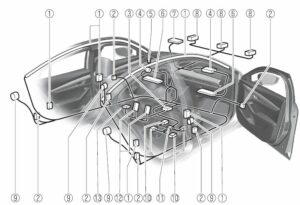
- Side and curtain inflators and air bags
- Side crash sensors
- Roll-over sensor, crash sensors, and diagnostic module (SAS unit)
- Driver/Front passenger inflators and air bags
- Air bag/seat belt pretensioner system warning indication/warning light
- Driver/Front passenger knee inflators and air bags
- Front passenger air bag deactivation indicator light
- Front air bag sensors
- Seat belt pretensioners
- Front passenger seat weight sensors
- Front passenger seat weight sensor control module
- Driver and front passenger seat belt buckle switches
- Driver seat slide position sensor
(Without Front Passenger Occupant Classification System) 
- Side and curtain inflators and air bags
- Side crash sensors
- Driver/Front passenger inflators and air bags
- Air bag/ seat belt pretensioner system warning indication /warning light
- Driver knee inflator and air bag
- Front air bag sensor
- Seat belt pretensioners
- Crash sensors, and diagnostic module (SAS unit)
How the SRS Air Bags Work
How the SRS Air Bags Work Your Mazda is equipped with the following types of SRS air bags. SRS air bags are designed to work together with the seat belts to help to reduce injuries during an accident. The SRS air bags are designed to provide further protection for passengers in addition to the seat belt functions. Be sure to wear seat belts properly.
Seat Belt Pretensioners The pretensioners operate differently depending on what types of air bags are equipped. For more details about seat belt pretensioner operation, refer to the SRS Air Bag Deployment Criteria Front The front seat belt pretensioners are designed to deploy in moderate or severe frontal, near frontal collisions. In addition, the pretensioners operate when a side collision or a roll-over accident (with roll-over sensor) is detected.
Rear Outboard* The rear outboard seat belt pretensioners are designed to deploy in moderate or severe frontal, near frontal collisions. In addition, the pretensioners operate when a side collision or a roll-over accident is detected.
Driver Air Bag The driver’s air bag is mounted in the steering wheel. When air bag crash sensors detect a frontal impact of greater than moderate force, the driver’s air bag inflates quickly helping to reduce injury mainly to the driver’s head or chest caused by directly hitting the steering wheel. For more details about air bag deployment, refer to “SRS Air Bag Deployment Criteria” (With Front Passenger Occupant Classification System) The driver’s dual-stage air bag controls air bag inflation in two energy stages. During an impact of moderate severity, the driver’s air bag deploys with lesser energy, whereas during more severe impacts, it deploys with more energy.  Front Passenger Air Bag The front passenger air bag is mounted in the front passenger dashboard. The inflation mechanism for the front passenger air bag is the same as the driver’s air bag. For more details about air bag deployment, refer to “SRS Air Bag Deployment Criteria”.
Front Passenger Air Bag The front passenger air bag is mounted in the front passenger dashboard. The inflation mechanism for the front passenger air bag is the same as the driver’s air bag. For more details about air bag deployment, refer to “SRS Air Bag Deployment Criteria”.
(With Front Passenger Occupant Classification System) In addition, the front passenger air bag is designed to only deploy in accordance with the total seated weight on the front passenger seat. For details, refer to the front passenger occupant classification system .
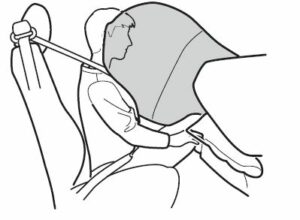 Driver and Front Passenger Knee Air Bags* The knee air bags are equipped under the instrument panel. If the air bag crash sensors receive a frontal impact of greater than moderate force, the knee air bags deploy immediately to reduce impact to the driver and front passenger’s legs. For more details about air bag deployment, refer to “SRS Air Bag Deployment Criteria”.
Driver and Front Passenger Knee Air Bags* The knee air bags are equipped under the instrument panel. If the air bag crash sensors receive a frontal impact of greater than moderate force, the knee air bags deploy immediately to reduce impact to the driver and front passenger’s legs. For more details about air bag deployment, refer to “SRS Air Bag Deployment Criteria”.
 Curtain Air Bags The curtain air bags are mounted in the front and rear window pillars, and the roof edge along both sides. When the air bag crash sensors detect a side impact of greater than moderate force, the curtain air bag inflates quickly and helps to reduce injury mainly to the driver and front and rear outboard passengers’ heads caused by directly hitting interior parts such as a door or window. For more details about air bag deployment, refer to “SRS Air Bag Deployment Criteria”
Curtain Air Bags The curtain air bags are mounted in the front and rear window pillars, and the roof edge along both sides. When the air bag crash sensors detect a side impact of greater than moderate force, the curtain air bag inflates quickly and helps to reduce injury mainly to the driver and front and rear outboard passengers’ heads caused by directly hitting interior parts such as a door or window. For more details about air bag deployment, refer to “SRS Air Bag Deployment Criteria”
In a side impact: Greater than moderate impact to one side of the vehicle will cause the curtain air bag on that side only to inflate.
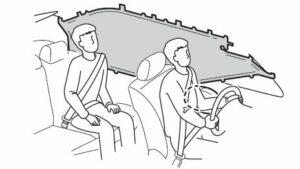 Only one side curtain air bag will deploy on the side of the vehicle that receives the force of an impact.
Only one side curtain air bag will deploy on the side of the vehicle that receives the force of an impact.
(With Front Passenger Occupant Classification System) In a roll-over: In response to a vehicle roll-over, both curtain air bags inflate.
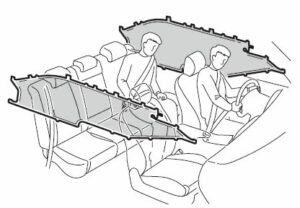 Both curtain air bags will deploy after the roll-over accident is detected.
Both curtain air bags will deploy after the roll-over accident is detected.
Warning Light/Beep A system malfunction or operation conditions are indicated by a warning. Refer to Air Bag/Seat Belt Pretensioner System Warning Indication/Warning Light on .
SRS Air Bag Deployment Criteria
SRS Air Bag Deployment Criteria This chart indicates the applicable SRS equipment that will deploy depending on the type of collision. (The illustrations are the representative cases of collisions.)
| SRS equipment | Types of collision | |||
| A severe frontal/near frontal collision | A severe side collision | A roll-over/near roll-over*2 | A rear collision | |
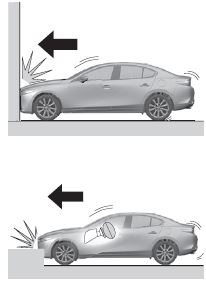 |
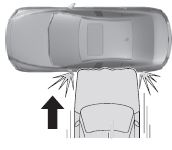 |
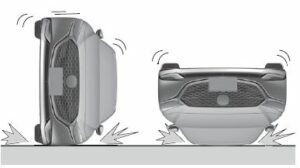 |
 |
|
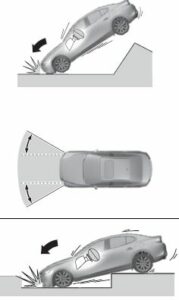 |
 |
|||
| SRS equipment | Types of collision | |||
| A severe frontal/near frontal collision | A severe side collision | A roll-over/near roll-over*2 | A rear collision | |
| Front seat belt pretensioner | X*1 | X*1 | X*1 | No air bag and seat belt pretensioner will be activated in a rear collision. |
| Rear seat belt pretensioner* | X | X | X | |
| Driver air bag | X | ― | ― | |
| Front passenger air bag | X*1 | ― | ― | |
| Knee air bag | X*1 | ― | ― | |
| Side air bags for driver and front passenger | ― | X*1 (impact side only) | ― | |
| Side air bags for rear passengers* | ― | X*1 (impact side only) | ― | |
| Curtain air bag | ― | X (impact side only) | X (both sides) | |
X: The SRS air bag equipment deploys in a collision. ―:The SRS air bag equipment does not deploy in a collision.
- (With Front Passenger Occupant Classification System) The front and side air bags for the front passenger and seat belt pretensioner and knee air bag are designed to deploy depending on the condition of the total seated weight on the front passenger seat.
- (With Front Passenger Occupant Classification System) In a roll-over accident, the seat belt pretensioners and the curtain air bags deploy.
NOTE
- In a frontal offset collision, the equipped air bags and pretensioners may all deploy depending on the direction, angle, and rate of impact. Some airbags and the pretensioners may not deploy depending on the level of the impact.
Limitations to SRS Air Bag
Limitations to SRS Air Bag In severe collisions such as those described previously in “SRS Air Bag Deployment Criteria”, the applicable SRS air bag equipment will deploy. However, in some accidents, the equipment may not deploy depending on the type of collision and its severity.
Limitations to front/near front collision detection: The following illustrations are examples of front/near front collisions that may not be detected as severe enough to deploy the SRS air bag equipment.
Impacts involving trees or poles 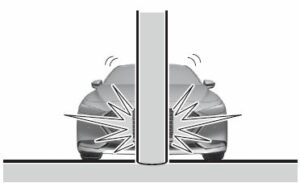 Frontal offset impact to the vehicle Rear-ending or running under a truck’s tailgate
Frontal offset impact to the vehicle Rear-ending or running under a truck’s tailgate
 Limitations to side collision detection: The following illustrations are examples of side collisions that may not be detected as severe enough to deploy the SRS air bag equipment.
Limitations to side collision detection: The following illustrations are examples of side collisions that may not be detected as severe enough to deploy the SRS air bag equipment.
Side impacts involving trees or poles
Side impacts with two-wheeled vehicles
 Roll-over (Without Front Passenger Occupant Classification System)
Roll-over (Without Front Passenger Occupant Classification System)  Limitations to roll-over detection (With Front Passenger Occupant Classification System):
Limitations to roll-over detection (With Front Passenger Occupant Classification System):
The following illustration is an example of an accident that may not be detected as a roll-over accident. Therefore, the seat belt pretensioners and curtain air bags may not deploy.
Pitch end over end 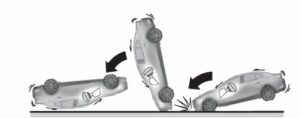
Driver and Front Passenger Occupant Classification System
Driver and Front Passenger Occupant Classification System First, please read “Supplemental Restraint System (SRS) Precautions” carefully.
Driver Seat Slide Position Sensor Your vehicle is equipped with a driver seat slide position sensor as a part of the supplemental restraint system. The sensor is located under the driver seat. The sensor determines whether the driver seat is fore or aft of a reference position and sends the seat position to the diagnostic module (SAS unit). The SAS unit is designed to control the deployment of the driver air bag depending on how close the driver seat is to the steering wheel. The airbag/seat belt pre-tensioner system warning light flashes if the sensor has a possible malfunction.
Front Passenger Seat Weight Sensors Your vehicle is equipped with a front passenger seat weight sensors as a part of the supplemental restraint system. These sensors are located under both of the front passenger seat rails. These sensors determine the total seated weight on the front passenger seat and monitor the seat belt buckle for the front passenger seat. The SAS unit is designed to prevent the front passenger front and side air bags and knee air bags, and seat belt pretensioner system from deploying if the front passenger air bag deactivation indicator light illuminates. To reduce the chance of injuries caused by deployment of the front passenger air bag, the system deactivates the front passenger front and side air bags and knee air bags, and also the seat belt pretensioner system when the front passenger air bag deactivation indicator light illuminates. Refer to the following table for the front passenger air bag deactivation indicator light illumination conditions. This system shuts off the front passenger front and side air bags and knee air bags, and seat belt pretensioner system, so make sure the front passenger air bag deactivation indicator light illuminates according to the following table. The air bag/ seat belt pretensioner system warning light flashes and the front passenger air bag deactivation indicator light illuminates if the sensors have a possible malfunction. If this happens, the front passenger front and side air bags and knee air bags, and seat belt pretensioner system will not deploy.
Front passenger air bag deactivation indicator light This indicator light illuminates to remind you that the front passenger front and side air bags and knee air bags, and seat belt pretensioners will not deploy during a collision. 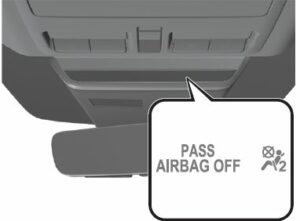 If the front passenger weight sensors are normal, the indicator light illuminates when the ignition is switched ON. The light turns off after a few seconds. Then, the indicator light illuminates or is off under the following conditions: Front passenger air bag deactivation indicator light on/off condition chart
If the front passenger weight sensors are normal, the indicator light illuminates when the ignition is switched ON. The light turns off after a few seconds. Then, the indicator light illuminates or is off under the following conditions: Front passenger air bag deactivation indicator light on/off condition chart
| Condition detected by the front passenger occupant classification system | Front passenger air bag deactivation indicator light | Front passenger front and side and knee air bags | Front passenger seat belt pre-tensioner system |
| Empty (Not occupied) | On | Deactivated | Deactivated |
| Child or child-restraint system*1 | On | Deactivated | Deactivated |
| Adult*2 | Off | Ready | Ready |
- If a larger child sits on the front passenger seat, the sensors might detect the child as being an adult depending on the child’s physique.
- If a smaller adult sits on the front passenger seat, the sensors might detect the person as being a child depending on the person’s physique.
The curtain air bag is ready for inflating regardless of what the front passenger air bag deactivation indicator light on/off condition chart indicates. If the front passenger air bag deactivation indicator light does not illuminate when the ignition is switched ON and does not illuminate as indicated in the front passenger air bag deactivation indicator light on/off condition chart, do not allow a child to sit in the front passenger seat and consult an Authorized Mazda Dealer as soon as possible. The system may not work properly in an accident.
WARNING Do not decrease the total seated weight on the front passenger seat:
When an adult or large child sits on the front passenger seat, decreasing the total seated weight on the front passenger seat required for air bag deployment is dangerous. The front passenger seat weight sensors will detect the reduced total seated weight condition and the front passenger front and side air bags and knee air bags, and the seat belt pretensioner system will not deploy during an accident. The front passenger will not have the supplementary protection of the air bag, which could result in serious injury. Decreasing the total seated weight on the front passenger seat could result in an air bag not deploying under the following conditions, for example: A front passenger is seated as shown in the following figure:

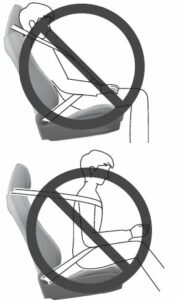
- A rear passenger pushes up on the front passenger seat with their feet.
- Luggage or other items placed under the front passenger seat or between the front passenger seat and driver seat that push up the front passenger seat bottom.
- Any accessories which might decrease the total seated weight on the front passenger seat are attached to the front passenger seat. The front passenger front and side air bags and knee air bags, and the seat belt pretensioner system will deactivate if the front passenger air bag deactivation indicator light illuminates.
Do not increase the total seated weight on the front passenger seat: When an infant or small child sits on the front passenger seat, increasing the total seated weight on the front passenger seat is dangerous. The front passenger seat weight sensors will detect the increased total seated weight, which could result in the unexpected deployment of the front passenger front and side air bags and knee air bags, and seat belt pretensioner system in an accident and may cause serious injury. Increasing the total seated weight on the front passenger seat could result in the front passenger front and side air bags and knee air bags, and seat belt pretensioner system deployment in an accident under the following conditions, for example:
- Luggage or other items are placed on the seat with the child in the child-restraint system. A rear passenger or luggage push or pull down on the front passenger seatback.
- A rear passenger steps on the front passenger seat rails with their feet. Luggage or other items are placed on the seatback or hung on the head restraint. Heavy items are placed in the seatback map pocket. The seat is washed. Liquids are spilled on the seat. The front passenger seat is moved backward, pushing into luggage or other items placed behind it. The front passenger seatback contacts the rear seat. Luggage or other items are placed between the front passenger seat and driver seat. Any accessories which might increase the total seated weight on the front passenger seat are attached to the front passenger seat.
CAUTION
- To assure proper deployment of the front air bag and to prevent damage to the sensors in the front seat bottoms: Do not place sharp objects on the front seat bottoms or leave heavy luggage on them.
- Do not spill any liquids on the front seats or under the front seats.
- To allow the sensors to function properly, always perform the following: Adjust the front seats as far back as possible and always sit upright against the seatbacks with seat belts worn properly.
- If you place your child on the front passenger seat, secure the child-restraint system properly and slide the front passenger seat as far back as possible.
NOTE
- The system requires about 10 seconds to alternate between turning the front passenger front and side air bags and knee air bags, and seat belt pretensioner system on or off. The front passenger air bag deactivation indicator light may illuminate repeatedly if luggage or other items are put on the front passenger seat, or if the temperature of the vehicle’s interior changes suddenly.
- The front passenger air bag deactivation indicator light may illuminate for 10 seconds if the total seated weight on the front passenger seat changes. The air bag/seat belt pretensioner system warning light might illuminate if the front passenger seat receives a severe impact.
- If the front passenger air bag deactivation indicator light does not illuminate after installing a child-restraint system on the front passenger seat, first, re-install your child-restraint system according to the procedure in this owner’s manual. Then, if the front passenger air bag deactivation indicator light still does not illuminate, install the child-restraint system on the rear seat and consult an Authorized Mazda Dealer as soon as possible.
- If the front passenger air bag deactivation indicator light illuminates when an adult is seated in the front passenger seat, have the passenger re-adjust their posture by sitting with their feet on the floor, and then re-fastening the seat belt. If the front passenger air bag deactivation indicator light still illuminates, move the passenger to the rear seat. If sitting in the rear seat is not possible, slide the front passenger seat as far back as possible. Consult an Authorized Mazda Dealer as soon as possible.
Driver and Front Passenger Buckle Switches
The buckle switches on the front seat belts detect whether or not the front seat belts are securely fastened and further control the deployment of the air bags.
Constant Monitoring
Constant Monitoring The following components of the air bag systems are monitored by a diagnostic system:
- Front air bag sensors Crash sensors, and diagnostic module (SAS unit) Side crash sensors Air bag modules Seat belt pretensioners Air bag/Seat belt pretensioner system warning light Related wiring
(With Driver and Front Passenger Occupant Classification System)
Driver seat slide position sensor Front passenger occupant classification sensor Front passenger occupant classification module Front passenger air bag deactivation indicator light Front passenger seat belt buckle switch The diagnostic module continuously monitors the system’s readiness. This begins when the ignition is switched ON and continues while the vehicle is being driven.
FAQs
An SRS (Supplemental Restraint System) airbag system is a vehicle safety feature designed to protect occupants in the event of a collision.
The Mazda 3 Hatchback 2023 is outfitted with numerous airbags, including front, side, and curtain airbags.
The front airbags deploy in a controlled manner depending on the severity of the impact and the occupants’ proximity. To ensure customized deployment, advanced sensors detect weight and position.
Side-impact airbags are located in the front seatbacks and provide additional upper body protection in the event of a side collision.
Curtain airbags deploy from the roofline and protect all occupants’ heads in both the front and rear seats.
No, the SRS airbags are designed to deploy automatically when a collision or impact is detected by the vehicle’s sensors.
Neither the driver nor the occupants can control the deployment of the SRS airbags. The vehicle’s safety systems are in charge of it.
Yes, the SRS airbags in the Mazda 3 Hatchback 2023 protect occupants in both the front and rear seats.
Other advanced safety features, such as advanced driver assistance systems and active safety technologies, are included in the Mazda 3 Hatchback 2023.
Advanced driver assistance systems, in conjunction with SRS airbags, help to prevent accidents and reduce the severity of collisions. They can help with braking, lane maintenance, and collision avoidance.
No, neither the driver nor the occupants can disable the SRS airbags. Disabling them jeopardizes the vehicle’s safety system.
The Mazda 3 Hatchback 2023 has SRS airbags as well as other safety features.
These features work together to improve occupant protection and lower the risk of injury during accidents or collisions.
Useful Links
View Full User Guide: Mazda 3 Hatchback 2023 User Manual| Auto User Guide
Download Link: Owner’s – Manuals, Guides, Maintenance Schedules | Mazda USA
2023 Mazda 3 Hatchback Specs, Price, Features, Mileage (Brochure)
Related Article
2023 Mazda 3 Hatchback Specs, Price, Features, Mileage (Brochure)
2023 Mazda 3 Specs, Price, Features, Mileage (Brochure)

